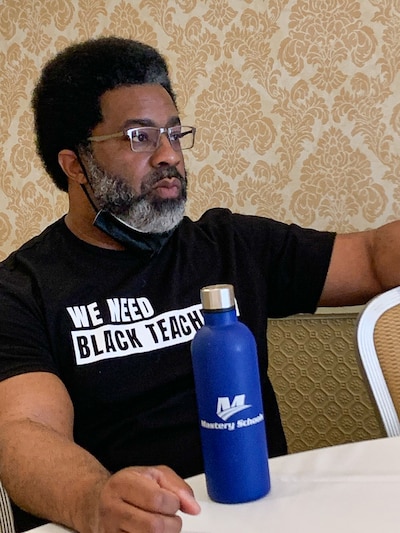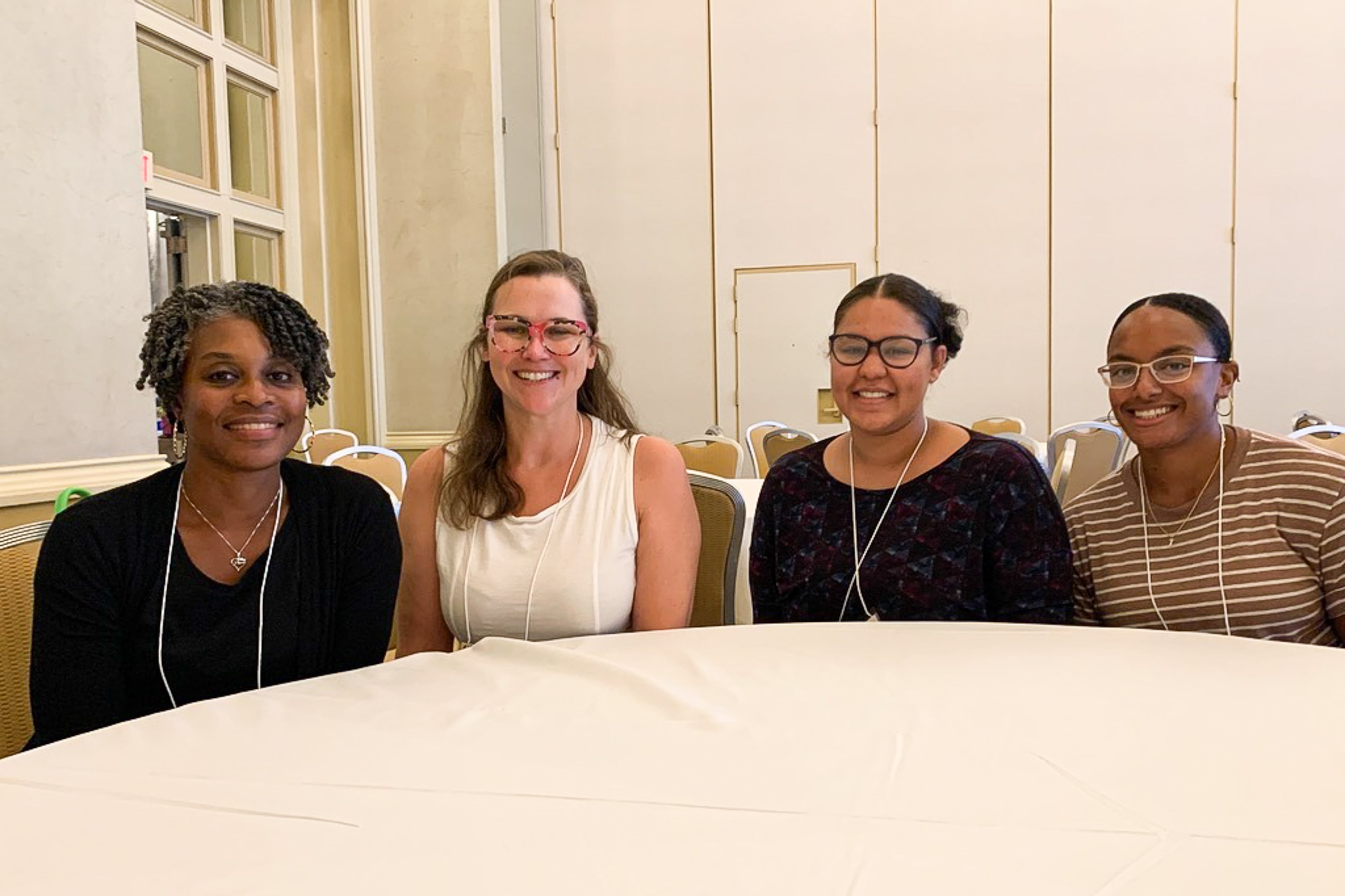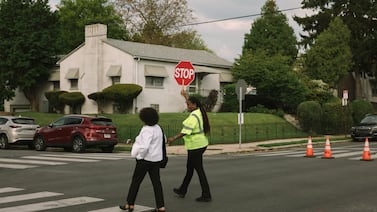Toni Washington, 24, who is about to start her career as a physical education teacher, describes herself as a decidedly unemotional person. That’s why she surprised herself when she choked up describing an encounter with a student at Colonial Middle School near Philadelphia during her time there as a long-term substitute.
The expression on the child’s face – as the sixth grader realized that she had a teacher who looked like her – is still seared in Washington’s mind and can, as the fledgling educator discovered, still provoke tears. It was a look of “pure awe.”
The incident confirmed for Washington that her career choice was the right one.
“It was a light bulb moment,” she said. “I realized how much it meant to her to have a Black teacher.”
Washington was among more than 130 people at an event last week in Philadelphia sponsored by the Center for Black Educator Development and the Education Trust, both national education advocacy groups, called “Building A Movement: Creating & Sustaining Diverse Teacher Workforces.” Teams from seven states, including Pennsylvania, were at the conference to brainstorm strategies for luring more people of color into the teaching profession.
The teaching ranks are still overwhelmingly dominated by white educators, even though the nation’s public school population has recently become majority non-white.
The trend has persisted despite evidence that all students benefit from a diverse workforce. One 2018 study showed that Black students who have one Black teacher between kindergarten and grade three are 13% more likely to graduate high school and 19% more likely to enroll in college than Black students from the same school who did not have a Black teacher. Other research shows that white students who have had Black teachers also benefit, not necessarily academically but in terms of future attitudes and life choices, such as where to live.
The conference “centered voices and experiences of diverse teachers and recognized the fact that a quality educator workforce is a diverse educator workforce,” said Sharif El-Mekki, a longtime Philadelphia teacher and principal who founded the Center for Black Educator Development. He emphasized the need for policymakers to “keenly listen to the lived experiences of Black, Indigenous, and Brown practitioners.”

Districts, states, and education leaders need to build a pipeline and take a long view of the issue, said Eric Duncan, senior policy analyst at Ed Trust, whose research and advocacy centers on equity.
“We wanted the state teams to leave with a power map, talking points, a data narrative, to form the basis of a pitch to policymakers in their states on what they need to do to increase diversity in the workforce,” he said.
The conference highlighted how policymakers need to think outside the box and develop innovative partnerships to address what El-Mekki called “the complex and entrenched barriers” to diversifying the teaching force – now about 80% white.
The barriers can be myriad for African Americans in particular to enter teaching, according to the research. Many Black students attended underfunded schools and didn’t have good experiences with their own educations, making the idea of teaching as a career unappealing.
Teaching is not a particularly high-paying profession – many students assume there is more money to be made elsewhere. Certification requirements can be onerous, and differ from state to state. Candidates must pass a licensing test called the Praxis used by Pennsylvania and several other states that, critics say, doesn’t necessarily measure the traits and knowledge that make a good teacher while showing wide gaps in passing rates among racial groups. High percentages of would-be teachers of color have difficulties passing the test and obtaining their licenses.
In addition to finding innovative ways to attract new talent, policymakers need to address teacher attrition, which is higher among teachers of color, said Ed Trust’s Duncan.
They were more likely to leave due to COVID-related issues, but also to report more political pressures around “what to teach and what not to teach” in their classrooms.”
“We have to make sure they have access to supports to stay in classroom environments that are culturally affirming,” he said.
Pennsylvania last month released a new strategy for recruiting and retaining more teachers. One of the goals is to “build a diverse workforce representative of the students we serve,” citing the research showing that students perform better when taught by teachers who share their race or language.
Students of all backgrounds who learn in diverse settings are less likely to engage in stereotyping, are more likely to live in integrated settings as adults, and are more likely to “exhibit increased intellectual self-confidence and develop critical leadership skills,” the state report said.
Pennsylvania has set a goal that by 2025, the percentage of educators of color entering the profession in the state will increase from 13% to 25%. Also last month, the General Assembly passed legislation making it easier for teachers from other states to become certified in Pennsylvania.
In the Colonial School District, covering several wealthy, mostly white towns on the northwest border of Philadelphia, just under 10% of students are Black, but hardly any of the teachers are. When Washington starts her first permanent teaching assignment later this month at the district’s 1,500-student Plymouth-Whitemarsh High School, she will be the only Black teacher on staff. She teaches health and physical education and coaches soccer.
Lisa Richardson is an English teacher at Upper Darby High School, one of the largest high schools in the state with more than 3,800 students, in a more working-class district on the southwest edge of Philadelphia. Half the student body is Black, but out of a professional staff of 236, Richardson said, just six teachers, two counselors, and one social worker at the high school are African American.
Richardson developed a course on African American literature, “which I got school board approval for,” she said. It became so popular that there are now more sections than she herself can handle.
Richardson is the only Black teacher in the English department, which means some sections are taught by white teachers. That’s not necessarily a problem – as she tells her students: “Would you say because I’m not British I can’t teach British literature?”
Still, students tell her they signed up for the course because they wanted her as a teacher.
“They want a Black teacher teaching a Black curriculum,” she said. “I can’t tell you how many 12th grade students tell me, ‘you’re the first Black teacher I ever had.’”
When Richardson started in 2013, students would stop her in the hallway and say, “You work here as a teacher?” Now, she advises a Black Student Union, a Stay Woke club for students of all backgrounds who want to unpack issues involving race, and a club on hair called Naptually Imperfect.
She loves it, but adds, “I’m at my club limit. I’m exhausted.”
Not to mention that she can “go through an entire day without seeing another Black adult, which she says is “isolating.” Teacher attrition is a problem across the board, but circumstances like that lead to higher attrition rates among the few Black teachers, she said.
Richardson was among 14 people from Pennsylvania, including at least four classroom teachers, who came to last week’s conference looking to help develop strategies for recruiting and retaining Black teachers. In Pennsylvania as a whole, 14.5% of students are Black, but just 3.8% of teachers are – and a high proportion teach in Philadelphia, where about a quarter of the educator workforce is Black, compared to two-thirds of the students. However, that percentage has declined over the past two decades.
Similarly, 12% of students but just 1% of teacherare Latinx. And 4% of students are Asian, compared to less than 1% of teachers.
In their caucus, the Pennsylvania delegation agreed that it is important to raise awareness of the issue through connections with officeholders, making sure districts have diversity officers and advisory committees, developing partnerships with outside organizations, keeping the issue in the public eye through op-eds and other media, and finding more systematic ways to recruit students when they are still in high school.
Other states at the conference were Tennessee, California, Illinois, Louisiana, North Carolina, and Texas.
The gathering included a few white teachers, including Mandy Edwards, a colleague of Washington’s at Plymouth-Whitemarsh. She teaches a hip-hop studies class, which includes “looking at injustices in the legal system.” She sponsors a Black cultural awareness group with a Black parent and community member who volunteers to help her without pay.
But Edwards said she struggles “as a white teacher to support” teachers of color “and not overstep. I felt weird coming here. We hear so many white voices.”
Washington, the physical education teacher at Plymouth Whitemarsh, is eager to start her first permanent job, but also feels the pressure.
“All eyes are on me,” she said. “I don’t want to fail myself and I don’t want to fail the kids.”
Dale Mezzacappa is a senior writer for Chalkbeat Philadelphia, where she covers K-12 schools and early childhood education in Philadelphia. Contact Dale at dmezzacappa@chalkbeat.org.






